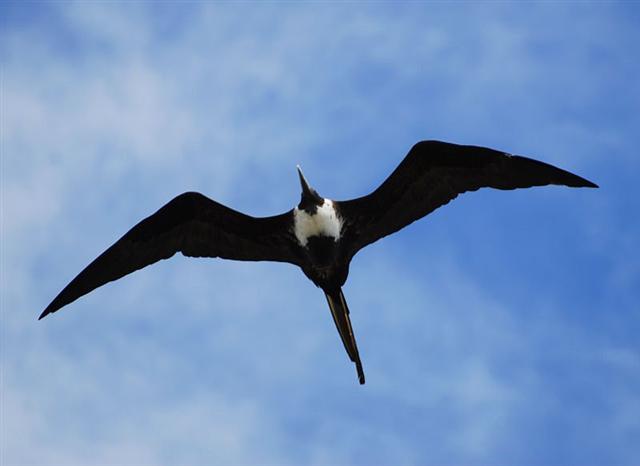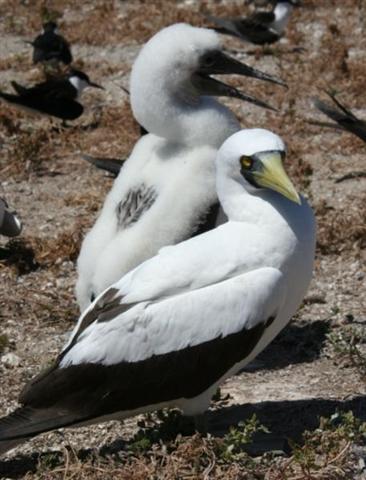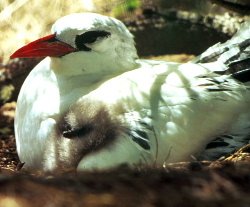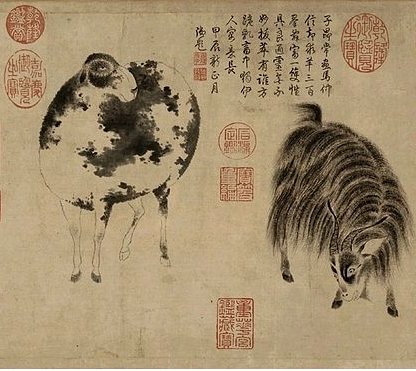The occurrence of 15 sets of 20 birds of
various kinds could mean we should put these 300 birds in
parallel with 15 glyphs (days) in the G text. No longer were
there one item of each kind, instead there was a multitude.
... In labouring to apprehend (lit. exhaust)
patterns fully, we are not necessitated to attempt an exhaustive
and complete research into the patterns of all the myriad
phenomena in the world. Nor can we attain our aim by fully
apprehending only a single one of these patterns. It is simply
necessary to accumulate (lit. pile up and tie together, chi
lei) a large number (of phenomena). Then (the patterns) will
become visible spontaneously ...
Hue. To congregate, to get together;
huega, meeting, reunion of persons,
heap,
pile of things; hue hau, ball of string. Huehue, a
fish, with a round body, dark back, and light belly. Vanaga. 1.
Calabash, gourd, pumpkin, pot, vase. P Pau.: hue, gourd.
Mgv.: hue, calabash gourd. Mq.: hue maoi,
calabash; hue ákau, pumpkin; hue, every sort of
vase with a large aperture. Ta.: hue, gourd, bottle. 2. A
pile, a heap; to accumulate, to agglomerate, to amass, to heap
up, to collect, to charge, to put in charge, to destine, to
consider, to camp, to pile up, to mass, to assemble, to conceal,
to reunite; hue ke, to choose; hue no, a halt;
hue ki ruga, to put on another; hakahue, to heap up,
to amass, to assemble; huega, mass, sheepfold, camp,
collection, company, society, council, corporation, faculty,
crowd, group, leage. Mgv.: hue, to collect, to gather
together, to heap up. Mq.: huevaevae, calf of the leg;
huefenua, the terrestrial globe. Ta.: hue, to heap
up. Churchill. Pau.: 1. Emotion. Ta.: huehue, to show
fear. 2. To carry, to conduct. Mgv.: akahue, to carry a
crop of foodstuff. Churchill. Mgv.: A fish. Ta.: huehue,
id. Mq.: huehue-kava, id. Sa.: sue, id. Churchill.
... There were two sets
of brothers, the Hecatoncheires (hundred-handed giants) and the
one-eyed Cyclopes, and they wanted revenge against Cronus. Zeus
stole down to Tartarus, released the monstrous creatures and
asked them to join him in the battle raging above. Delighted by
their unexpected freedom, the Cyclopes set to work to help the
gods. They fashioned a helmet of darkness for Hades, a trident
for Poseidon and, above all, thunderbolts for Zeus. With these
new weapons and their monstrous allies, the gods routed the
Titans. After their victory, the gods cast lots to divide up the
Universe. Poseidon became lord of the sea, Hades won the
Underworld and Zeus was allotted the sky. Zeus then placed the
altar of the gods in the sky as the constellation Ara in lasting
gratitude for their victory over the Titans ...
|
Sky |
Zeus |
|
Sea |
Poseidon |
|
Underworld |
Hades |
Possibly the missing 4th level of the Greeks
was Mother Earth. If all the gods anciently were stars, which
Aristotle said, then she should not be counted.
... In Hindu legend there was a mother goddess called Aditi,
who had seven offspring. She is called 'Mother of the Gods'.
Aditi, whose name means 'free, unbounded, infinity' was
assigned in the ancient lists of constellations as the regent of
the asterism Punarvasu. Punarvasu is dual in form
and means 'The Doublegood Pair'. The singular form of this noun
is used to refer to the star Pollux ...
And 4 * 20 = 80 (as the day number at 0h) suggests the
season before equinox,
the childish days prior to growing up.
|
manu tara |
|
20 |
*116 (POLLUX)
*117
*118
*119
*120 |
he |
pi riuriu
kava eoeo
te verovero
ka araara
kukuru toua |
a Teke. a Oti. |
|
20 |
|
20 |
|
20 |
|
20 |
|
20 |
*121 (NAOS) |
makohe |
|
20 |
*122 |
kena |
|
20 |
*123 |
tavake |
|
20 |
*124 (AL TARF)
*125 |
ruru
taiko |
|
20 |
|
20 |
*126
*127 |
kumara
kiakia |
|
20 |
|
20 |
*128
*129
*130
(BEEHIVE) |
tuvi
tuao
tavi |
|
20 |
|
20 |
|
Manu tara. Sooty tern. The
names of the age levels of the sooty tern were
earlier used as children's names (Routledge). These
names were (Barthel): pi(u) riuriu, kava
'eo'eo, te verovero, and ka 'ara'ara.
Fischer. Skulls with incised
carvings, imbued with power by Makemake, were
placed in the fowl house to promote the egg-laying
capacity of the occupants. It may seem a long call
from the domestic fowl to the sooty tern, but both
are birds and lay eggs. The sooty tern (manu tara)
comes to breed in large numbers in July or August
off the southwestern point formed by the crater of
Rano-kao on three rocky islets, of which the
only one accessible to swimmers is Motu-nui. (Buck) |
... The sooty tern (manu tara)
comes to breed in large numbers in July or August
off the southwestern point formed by the crater of
Rano-kao on three rocky islets
...
Pollux (196)
rose heliacally in July 15 and the Beehive (210) fourteen
days later in July 29:
|
he ruma. |
he tuitui koviro. |
he vitiviti. |
he
marikuru. |
he
pi riuriu |
he kava eoeo |
|
Riuriu,
to go around in a circle.
Eoeo.
Ashes. Eoeo reherehe 'weak ashes': a coward.
Verovero,
to throw, to hurl repeatedly, quickly (iterative of
vero).
Ará-ará,
to signal, to send signals with the hand (to another
person in the distance). |
|
MAY 8 |
9 |
10 (130) |
11 |
12 |
13 (*53) |
 |
 |
 |
 |
 |
 |
|
Ga2-18 |
Ga2-19 |
Ga2-20
(50) |
Ga2-21 |
Ga2-22 |
Ga2-23 |
|
ρ Gemini (?) (112.1),
Eskimo
Nebula
= NGC2392 Gemini
(112.2)
ANTARES (α Scorpii) |
Al Dhirā'-5 (Forearm) /
Punarvasu-7 (The Two Restorers of Goods) /
Mash-mashu-Mahrū-10 (Western One of the Twins)
CASTOR
= α Gemini
*113.4 = *41.4 + *72.0 |
ANA-TAHUA-VAHINE-O-TOA-TE-MANAVA-7 (Pillar for
Elocution)
υ Gemini (114.0),
MARKAB PUPPIS
= κ Puppis
(114.7), ο Gemini (114.8),
PROCYON
= α Canis Minoris
(114.9) |
α
Monocerotis
(115.4), σ Gemini (115.7)
*74.0 = *115.4 - *41.4 |
Mash-mashu-arkū-11 (Eastern One of the Twins)
κ Gemini (116.1),
POLLUX
= β Gemini
(116.2), π Gemini (116.9) |
AZMIDISKE
= ξ Puppis
(117.4)
*76.0 = *117.4 - *41.4 |
|
Procyon was the Pillar for Elocution
- certainly a reference to Hermes (Yggr). And Toa-te-manava could have inspired the
sugarcane (toa) sequence of items here brought
onboard.

... When this tremendous task had
been accomplished Atea took a third husband,
Fa'a-hotu, Make Fruitful. Then occurred a
curious event. Whether Atea had wearied of
bringing forth offspring we are not told, but
certain it is that Atea and her husband
Fa'a-hotu exchanged sexes. Then the [male] eyes
of Atea glanced down at those of his wife
Hotu and they begat Ru. It was this Ru
who explored the whole earth and divided it into
north, south, east, and west ...
First Atea was female (vahine) and
then male. She behaved like Mercury - with
indeterminate sex, sometimes below (female) and
sometimes above (male) the horizon.. |
|
July 11 |
12 (193) |
13 |
(*115 → Mercury) |
15 |
16 |
|
°July 7 |
8 |
9 |
10 (*111) |
11 |
12 (193) |
|
'June 14 |
15 |
16 |
17 (*88) |
18 |
19 (*90) |
|
"May 31 |
Te Maro 1 |
2 |
3 |
4 (*75) |
5 (156) |
|
On the
twenty-fifth day [raa] of the first month
('Vaitu Nui'), Ira and Makoi set sail;
on the first day [te raa po
rae] of the month of June ('Maro'), the
bow [te ihu] of Ira's canoe touched land
again. [E:17] |
|
CLOSE TO THE FULL
MOON: |
|
NOV 7 |
8 |
9 |
10 (314 → π) |
11 |
12 (*236) |
|
ν
Aquilae (Ant.) (295.0),
ALBIREO
- Hen's Beak
=
β
Cygni
(295.5) |
ALSAFI
(Fire Tripod)
=
σ
Draconis
(296.0),
μ
Aquilae (296.3),
ι
Aquilae (Ant.)
(296.8), κ Aquilae (Ant.) (296.9) |
ε Sagittae (297.1), σ Aquilae (Ant.) (297.4),
SHAM
(Arrow)
= α Sagittae
(297.8)
*256.0 = *297.4 - *41.4 |
β Sagittae (298.0), χ Aquilae (298.3), ψ Aquilae
(298.8) |
υ Aquilae (299.1),
TARAZED
(Star-striking Falcon)
= γ Aquilae
(299.3), δ Sagittae (299.6), π Aquilae (299.9) |
Sravana-23 (Ear or Three Footprints)
TYL
=
ε
Draconis
(300.0),
ζ
Sagittae (300.1),
ALTAIR
(Flying Eagle)
=
α
Aquilae
(300.3),
ο
Aquilae (300.5),
BEZEK
=
η
Aquilae
(Ant.)
(300.8) |
 |
|
Jan 10 |
11 |
12 |
(378 → Saturn) |
14 |
15 (*300) |
|
°Jan 6 |
7 (372) |
8 |
9 |
10 (*295) |
11 |
|
'Dec 14 |
15 |
16 (350) |
17 |
18 |
19 (*273) |
|
"Nov 30 |
"Dec 1 |
2 (336 = 4 * 84) |
3 |
4 |
5 (*259) |
.jpg)
|
he te verovero |
he ka araara |
he kukuru toua |
he makohe |
he kena |
he tavake |
|
Tou.
In ancient times, a tou was someone who
had recovered from an epidemic, but whose
illness meant that someone else in the family
had to die. The tou were regarded as
portents of evil. Toutou, lush; fertile
(land). Toûa: Egg yolk; the colour
yellow; soft, fibrous part of tree bark; toûa
mahute, mahute fibres. Vanaga. Toua:
Wrath, anger, rage, revenge, battle, combat,
debate, dispute, dissension, uprising, revolt,
quarrel, fight, hostility (taua); toua
rae, to provoke, rae toua, to open
hostilities, toua kakai, to rebuke,
tuki toua, to stir up dissension; totoua,
hostility; hakatoua, fighter, warrior. P
Mgv.: toua, war, battle. Mq.: toua,
war, dispute, quarrel. The form with o is
found only in these three languages, taua
is found in the general migration, Rapanui is
the only speech which has both. Toutou,
fertile (tautau); hakatoutou, to
fertilize. Mq.: taútaú, fertile.
Toùvae, to run; hakauruuru toùvae,
id.
Churchill.


 |
|
MAY 14 |
(500 = 365 +
135 ) |
16 (136) |
17 |
18 |
19 |
 |
 |
 |
 |
 |
 |
|
Ga2-24 (54) |
Ga2-25 → 225 |
Ga2-26 |
Ga2-27 → π |
Hanga Te Pau |
Ga2-29 (59) |
|
φ
Gemini (118.4)
*77.0 = *118.4 - *41.4 |
DRUS (Hard)
= χ Carinae
(119.9) |
ω
Cancri
(120.2) |
8h
(121.7)
χ Gemini (121.0),
NAOS
= ζ Puppis
(121.3) |
ρ
Puppis (122.0),
HEAP OF FUEL
= μ Cancri
(122.1),
ζ
Monocerotis (122.3), ψ
Cancri (122.6),
REGOR (Roger backwards)
= γ Velorum
(122.7) |
TEGMINE = ζ Cancri
(123.3) |
.jpg) |
|
July 17
(*118) |
18 |
19 (200) |
20 (*121) |
21 |
22 / 7 |
|
°July 13 |
14 |
15 |
16 |
17 (*118) |
18 (199) |
|
'June 20
(*91) |
SOLSTICE |
'June 22
(173) |
23 |
ST JOHN'S DAY |
25 (*96) |
|
"June 6 (*77) |
7 |
8 |
9 (160) |
TE MARO 10 |
11 |
|
he ea.a Ira.he iri he oho ki runga anake.
i te angahuru o te raa o
te maro i iri ai - Ira got
up. They all climbed to the top of the hill.
They climbed up on the
tenth day of the month of June ('Maro’).
[E:18] |
|
CLOSE TO THE
FULL MOON: |
|
NOV 13 |
14 |
15 |
16 |
17 (321) |
18 (*242) |
|
ι Sagittarii (301.2),
TEREBELLUM
= ω Sagittarii,
ξ Aquilae (301.3),
ALSHAIN (Falcon)
= β Aquilae
(301.6), φ Aquilae (301.8) |
ε Pavonis, θ Sagittarii (302.3), γ Sagittae
(302.5), μ Pavonis (302.7) |
τ Aquilae (303.8) |
20h
(304.4)
η Sagittae (304.2), δ Pavonis (304.4)
*263.0 = *304.4 - *41.4 |
SHANG WEI (Higher Guard)
= κ Cephei
(305.2),
θ
Sagittae (305.4),
TSEEN FOO
(Heavenly Raft)
= θ Aquilae (Ant.)
(305.6), ξ Capricorni (305.8)
*264.0 = *305.4 - *41.4 |
TSO
KE (Left Flag)
= ρ Aquilae
(306.3) |

... In late September or
early October 130, Hadrian and his entourage,
among them Antinous, assembled at Heliopolis to
set sail upstream as part of a flotilla along
the River Nile. The retinue included officials,
the Prefect, army and naval commanders, as well
as literary and scholarly figures. Possibly also
joining them was Lucius Ceionius Commodus, a
young aristocrat whom Antinous might have deemed
a rival to Hadrian's affections. On their
journey up the Nile, they stopped at Hermopolis
Magna, the primary shrine to the god Thoth. It
was shortly after this, in October [in the year
A.D.] 130 - around the time of the festival of
Osiris - that Antinous fell into the river and
died, probably from drowning. Hadrian publicly
announced his death, with gossip soon spreading
throughout the Empire that Antinous had been
intentionally killed. The nature of Antinous's
death remains a mystery to this day, and it is
possible that Hadrian himself never knew;
however, various hypotheses have been put
forward. One possibility is that he was murdered
by a conspiracy at court. However, Lambert
asserted that this was unlikely because it
lacked any supporting historical evidence, and
because Antinous himself seemingly exerted
little influence over Hadrian, thus meaning that
an assassination served little purpose. Another
suggestion is that Antinous had died during a
voluntary castration as part of an attempt to
retain his youth and thus his sexual appeal to
Hadrian. However, this is improbable because
Hadrian deemed both castration and circumcision
to be abominations and as Antinous was aged
between 18 and 20 at the time of death, any such
operation would have been ineffective. A third
possibility is that the death was accidental,
perhaps if Antinous was intoxicated. However, in
the surviving evidence Hadrian does not describe
the death as being an accident; Lambert thought
that this was suspicious. Another possibility is
that Antinous represented a voluntary human
sacrifice. Our earliest surviving evidence for
this comes from the writings of Dio Cassius, 80
years after the event, although it would later
be repeated in many subsequent sources. In the
second century Roman Empire, a belief that the
death of one could rejuvenate the health of
another was widespread, and Hadrian had been ill
for many years; in this scenario, Antinous could
have sacrificed himself in the belief that
Hadrian would have recovered. Alternately, in
Egyptian tradition it was held that sacrifices
of boys to the Nile, particularly at the time of
the October Osiris festival, would ensure that
the River would flood to its full capacity and
thus fertilize the valley; this was made all the
more urgent as the Nile's floods had been
insufficient for full agricultural production in
both 129 and 130. In this situation, Hadrian
might not have revealed the cause of Antinous's
death because he did not wish to appear either
physically or politically weak. Conversely,
opposing this possibility is the fact that
Hadrian disliked human sacrifice and had
strengthened laws against it in the Empire ... |
|
Jan 16 |
17 |
18 (383) |
19 |
20 |
21 |
|
°Jan 12 |
13 (378 →
Saturn) |
14 |
15 (*300) |
16 |
17 |
|
'Dec 20 (354) |
SOLSTICE |
22 |
23 |
CHRISTMAS EVE |
25 (*279) |
|
"Dec 6 (340)
|
7 |
8 |
9 |
10 |
11 (*265) |
|
... The evening of 23 June, St. John's Eve, is
the eve of celebration before the Feast Day of
Saint John the Baptist. The Gospel of Luke (Luke
1:36, 56-57) states that John was born about six
months before Jesus; therefore, the feast of
John the Baptist was fixed on 24 June, six
months before Christmas Eve ... |
|
he ruru |
he taiko |
he kumara |
he kiakia |
he tuvi |
|
Sula cyanops
... It should be pointed out that
the combined name ruru-taiko refers in
MAO. to a black petrel (Procellaria
parkinsoni). There are no cultural data
available for ruru, which seems to be derived
from PPN. *lulu 'owl'...
There are no cultural data available for ...
taiko (compare RAR. taiko 'black petrel',
MGV. tiaku 'petrel?, omen of death', but the
textual association of taiko and spirits
should be dept in mind ...
...
The transference of the name for
sweet potatoes, kumara, to a sea bird (Oestrelata
incerta or Oestrelata leucoptera)
presents a problem in taxonomy. In a short
recitation that accompanies the string game, the
next bird on the list, kiakia, the white
tern, is associated with the leaves of the sweet
potato ...
White tern. Leucanus albus royanus ...
... Grey tern, Tuvituvi (Procelsterna
caerulea skottsbergi) ...
Anous stolidus
unicolor
... The dark
brown tern with a round tail is called tuao
... I was told that tavi is a small,
lead-colored bird that lives on the little islets (motu)
off the coast. He is supposed to look like the
tuvi, the grey tern, and owes his name to his
call ... |
|
MAY 20 (140) |
21 (*61) |
22 |
23 |
24 (144 = 12 *
12) |
 |
 |
 |
 |
 |
|
Ga3-1
(60) |
Ga3-2 |
Ga3-3 |
Ga3-4 |
Ga3-5 |
|
AL TARF (The End)
= β Cancri
(124.3)
RAS ALGETHI (α
Herculis) |
χ Cancri (125.2),
BRIGHT FIRE
= λ Cancri
(125.4)
*84.0 = *125.4 - *41.4 |
AVIOR
= ε Carinae
(126.4), φ Cancri (126.8)
*85.0 = *126.4 - *41.4 |
ο Ursae Majoris
(127.4)
*86.0 = *127.4 - *41.4 |
Pushya-8
(Nourisher)
υ Cancri (128.1),
θ CANCRI
(128.2) |
|
July 23 (204) |
24 (*125) |
25 |
26 (187 + 20) |
27 (208) |
|
°July 19 (200) |
20 (*121) |
21 |
22 / 7 |
23 (204) |
|
26 (177 = 6 * 29½) |
'June 27 |
28 |
29 (*100) |
SIRIUS |
|
"June 12 |
13 (*84) |
14 (165 + 365) |
Te Maro 15 |
16 |
|
Day 365 + 166 = 531 = 18 * 29½ (Te
Maro 15).



|
|
... Makoi got up and began
to familiarize himself with the (new) land. (This
took place) on the fifteenth
day of the month of June ('Maro'). He
went toward the sheer face of the rocks (titi o
te opata), was astonished (aaa), came up
to the middle (of the outer rim of the crater), and
stood at the very edge. He looked down and saw the 'Pu
Mahore of Hau Maka' (on the
coast) and said, 'There it is, the hole of the
mahore fish of Hau Maka!' He turned his
face and looked toward the back (i.e., in the
direction of the crater). No sooner had he seen how
the dark abyss opened up (below him), when a
fragrant breeze came drifting by. Again Makoi
said, 'This is the dark abyss of Hau Maka'.
He turned around, walked on in utter amazement, and
arrived at the house. He spoke to Ira, 'Hey
you, my friends! How forgetful we (truly) are. This
place is adequate (? tau or 'beautiful'), the
dark abyss lies there peacefully!' Ira
replied, 'And what should that remind us of up
here?' All arose and climbed up. They went on and
arrived; they all had a good look (at the inside of
the crater). They returned home and sat down. Night
fell, and they went to sleep
... [E:19]
 |
|
CLOSE TO THE FULL
MOON: |
|
NOV 19 (*243) |
20 (324) |
21 |
22 |
23 |
|
GREDI (Goat)
=
α
Capricorni
(307.2),
σ
Capricorni (307.5),
ALSHAT (The Sheep)
=
ν
Capricorni
(307.9) |
Al Sa’d al Dhabih-20 (Lucky One of the Slaughterers)
/
Ox / Herd Boy-9
(Buffalo)
DABIH
=
β
Capricorni
(308.0),
κ
Sagittarii (308.1),
SADIR (Hen's Breast)
=
γ
Cygni
(308.4),
PEACOCK
=
α
Pavonis
(308.7)
*267.0 = *308.4 - *41.4 |
OKUL = π Capricorni
(309.6),
BOS = ρ Capricorni
(309.9)
ARNEB (α Leporis)
MINTAKA (δ Orionis)
|
ο
Capricorni (310.2),
θ
Cephei (310.5)
HEKA (λ Orionis)
ALNILAM (ε Orionis)
|
ROTTEN MELON
= ε Delphini,
φ Pavonis (311.2), η Delphini (311.4), ζ Delphini, ρ
Pavonis (311.7)
PHAKT (α Columbae)
ALNILAK (ζ Orionis)
|
 |
|
Jan 22 |
23 (388) |
24 |
25 (*310) |
26 |
|
°Jan 18 (383) |
19 |
20 |
21 (*306) |
22 |
|
'Dec 27 (360) |
28 |
29 |
30 |
31 (*284) |
|
"Dec 12 (*266) |
13 |
14 (348) |
14 |
16 |

|






.jpg)




.jpg)








